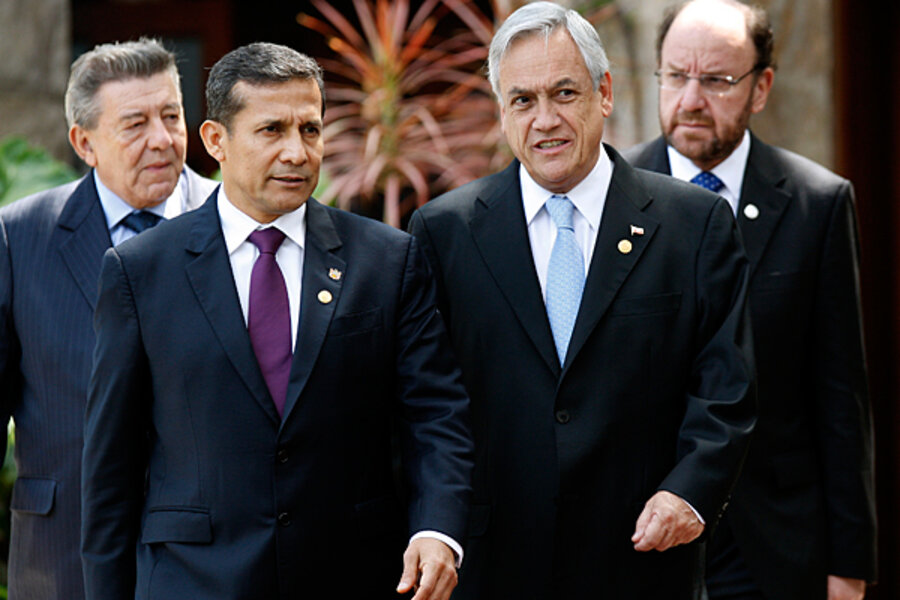Chile-Peru border dispute moves from battlefield to courtroom
Loading...
| Santiago, Chile
Lawyers from Peru and Chile complete their arguments tomorrow in a trial to determine once and for all which country controls what acreage of the Pacific Ocean.
The trial will end a five-year process in which Peru has sought to expand its maritime territory, fixing a border that Peru claims was left undecided when the two countries finished the War of the Pacific in 1883.
That the two sides are fighting it out in a varnished wood courtroom rather than the battlefield shows how the world has changed in the last generation. Peru went to war with Ecuador over a patch of the Amazon in 1995, and Chile came close to war with Argentina in 1978 over control of part of Tierra del Fuego. Around the world, scores of boundaries remain in dispute, but countries have gradually moved their conflicts to the legal arena.
This route to resolving territorial disputes is freshly fragile. After the same court last month ruled against Colombia in a territorial dispute with Nicaragua, Bogota pulled out of a treaty committing it to respect the court’s decisions. The court's ruling this time around – and how Chile and Peru react to it – could set the tone for future cases around the region and the world.
“Maybe for Europeans and North Americans it seems very 19th century, people fighting over boundary lines. But it can become a salient issue in hands of politicians who want to use it for their own political ends,” says Charles Shapiro, president of the Institute of the Americas in La Jolla, California.
Rally support
The conflict dates back to the 19th century, when Peru, Chile, and Bolivia fought the War of the Pacific for control of the mineral deposits of the Atacama desert. The resulting demarcation wasn’t agreed on until 1929, when the United States brokered a settlement between Peru and Chile. But Peru insists the sea border was never definitive, and that subsequent agreements creating a straight east-west marine limit were just fisheries agreements and not formal treaties.
Peru now wants to pivot the line toward the southwest, giving Peruvians more access to the anchovies widely used in fishmeal. Chile and Peru together produce most of the world’s fish meal, the dried, ground fish used as poultry food and fertilizer.
The fight is based in domestic politics, says Mr. Shapiro. “It’s a way to rally domestic support,” he says.
Ahead of the trial, Chilean President Sebastian Piñera visited his Peruvian counterpart, Ollanta Humala, and both stated they would abide by the court’s ruling. But a decision that removes acreage from Chilean control will still be controversial — 73 percent of Chileans said in 2010 and 2011 polls that the government should refuse to recognize any loss of territory at the hearings in The Hague.
And according to polls published by GfK Peru and GfK Chile at the end of November, a majority of both Chileans and Peruvians expect Chile to reject a loss. Peruvian newspapers reported last year that the Chilean military was prepared for war with Peru, and a poll by the Catholic University of Peru in 2010 found 20 percent of Peruvians expected a decision in their country’s favor would lead to war.
Greg Weeks, a professor of political science at the University of North Carolina – Charlotte, says a decision in favor of Peru could also embolden Bolivia, which is planning to sue Chile to demand direct access to the Pacific, which it lost in the War of the Pacific. Every March 23, landlocked Bolivia mourns Chile’s conquest of its Pacific ports with the national holiday Sea Day.
With such decisions, the International Court of Justice in The Hague "risks alienating its members, who then leave,” says Mr. Weeks, who has written extensively on Chile. If the trials themselves become a destabilizing force, “that would be an unfortunate irony,” Weeks says.
That is just what happened at the end of November, after the same court granted Nicaragua a portion of Colombia’s Caribbean waters. Colombians reacted angrily and President Juan Manuel Santos pulled his country out of the 1948 treaty binding signatories to the Hague court’s decisions.
While Colombia and Nicaragua are likely to abide by the decision, the case shows how hard it can be to accept a loss – especially against a militarily inferior foe.
Something similar may happen if Peru prevails against Chile, but Mr. Shapiro says prosperity and growing ties between the countries make war unlikely.
Natural resource powerhouses
Even as nationalists in each country decry the other for supposed territorial desires and the mass media is blanketed with coverage of the Hague trial, everyday life in each country is increasingly integrated.
Both Peru and Chile are natural resource powerhouses with fast-growing economies. Presidents of the two countries, along with Mexico and Colombia, signed the Pacific Alliance free trade pact in June. Peruvians shop at Chile-based department stores like Falabella and Ripley and almost half of Chile’s immigrant visas are granted to Peruvians.
At the border itself, people from Chile and Peru – and Bolivia – interact freely, crossing into Peru for cheap medical care and going to Chile for higher-paying jobs.
Such connections should mute any reactions to the verdict, Shapiro says. As countries get wealthier, “people see a piece of land this way or that way it isn’t going to make a huge impact on the destiny of their nation. It becomes easier to settle.”
Indeed, the public is looking forward to a future of cooperation, says Francisco Jiménez, head of public opinion research at the polling company Adimark GfK in Santiago. “People are quite positive,” Mr. Jiménez says.
The GfK polls found more than 70 percent of the public in each country agree with statements like “Peru and Chile should think about a cooperative future” and “Peru and Chile should increase commercial and economic relations.”
The court will most likely release its decision in the middle of 2013.







